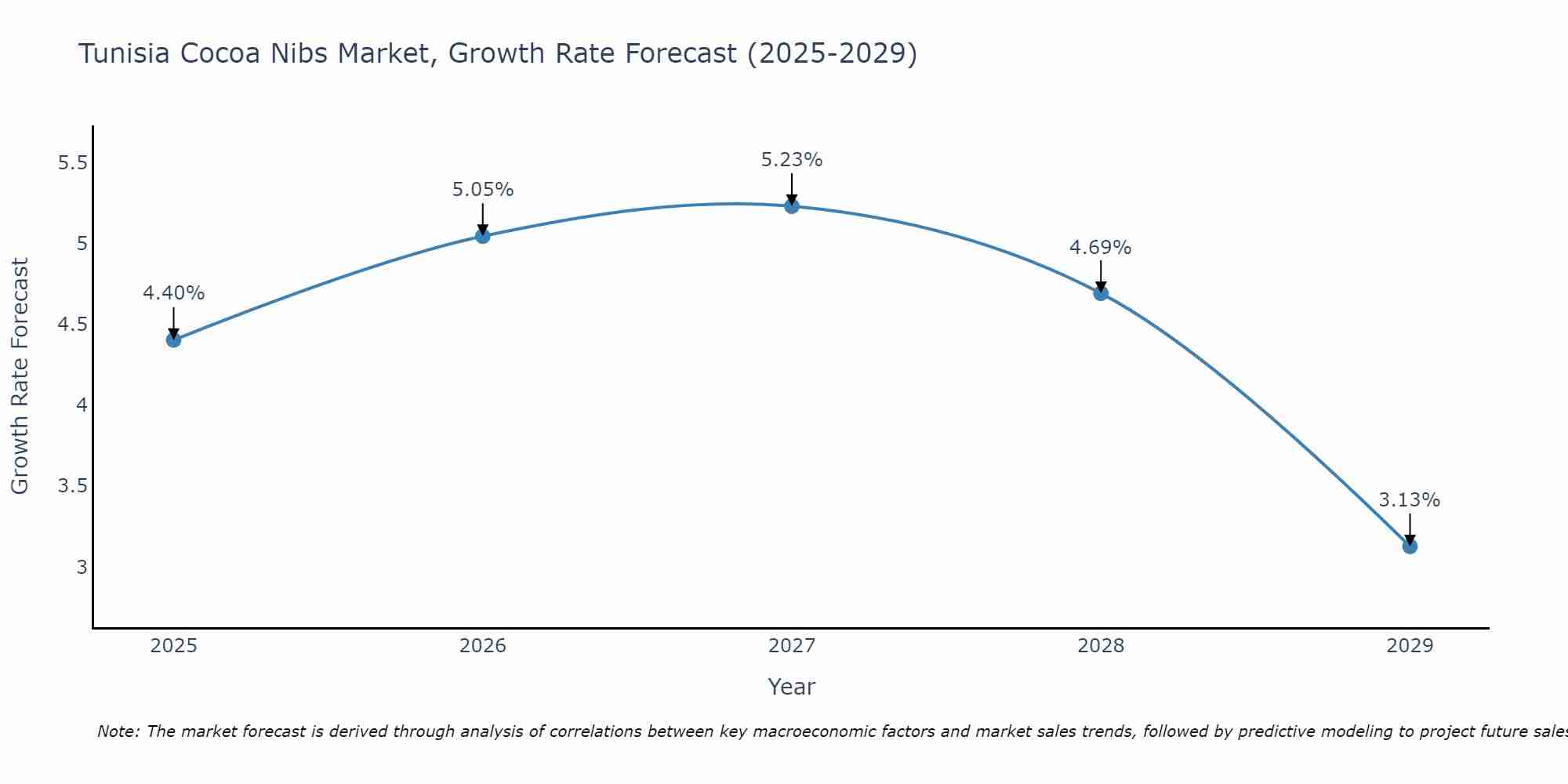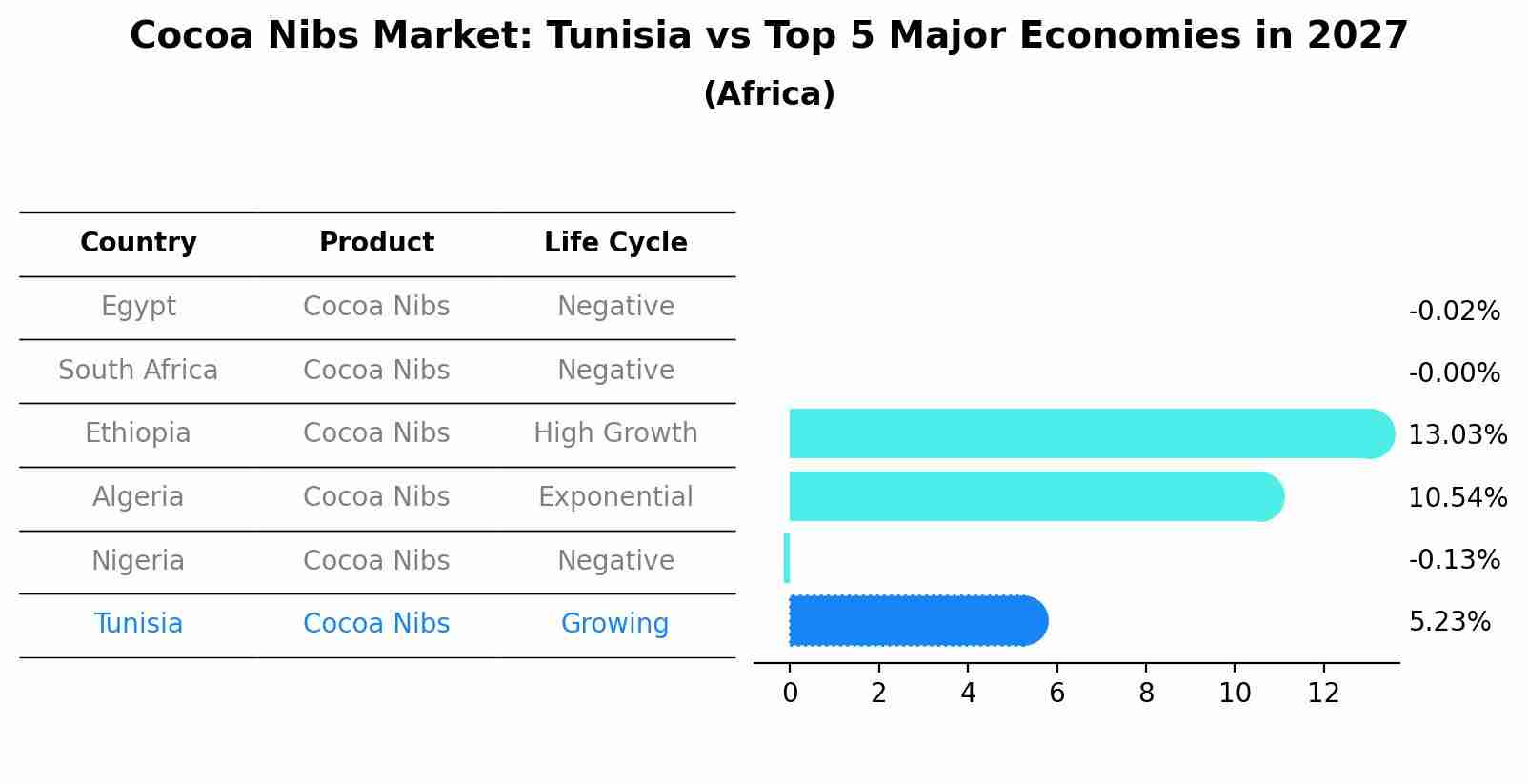Tunisia Cocoa Nibs Market (2025-2031) Outlook | Forecast, Analysis, Growth, Share, Trends, Size, Industry, Revenue, Value & Companies
| Product Code: ETC107293 | Publication Date: Jun 2021 | Updated Date: Jun 2025 | Product Type: Report | |
| Publisher: 6Wresearch | Author: Ravi Bhandari | No. of Pages: 70 | No. of Figures: 35 | No. of Tables: 5 |
Tunisia Cocoa Nibs Market Size Growth Rate
The Tunisia Cocoa Nibs Market is projected to witness mixed growth rate patterns during 2025 to 2029. The growth rate begins at 4.40% in 2025, climbs to a high of 5.23% in 2027, and moderates to 3.13% by 2029.

Cocoa Nibs Market: Tunisia vs Top 5 Major Economies in 2027 (Africa)
In the Africa region, the Cocoa Nibs market in Tunisia is projected to expand at a growing growth rate of 5.23% by 2027. The largest economy is Egypt, followed by South Africa, Ethiopia, Algeria and Nigeria.

Tunisia Cocoa Nibs Market Overview
The Tunisia Cocoa Nibs Market is experiencing steady growth driven by increasing consumer awareness of the health benefits associated with cocoa nibs. Cocoa nibs are rich in antioxidants, fiber, and minerals, making them a popular choice among health-conscious individuals. The market is also benefiting from the growing trend of incorporating cocoa nibs into various food and beverage products such as chocolates, baked goods, and smoothies. Additionally, the rising demand for organic and ethically sourced cocoa nibs is driving market expansion, with consumers showing a preference for sustainable and high-quality products. Key players in the Tunisia Cocoa Nibs Market are focusing on product innovation, strategic partnerships, and marketing initiatives to capitalize on the growing demand and gain a competitive edge in the market.
Tunisia Cocoa Nibs Market Trends
The Tunisia Cocoa Nibs market is experiencing growth due to increasing consumer awareness about the health benefits of cocoa. Consumers are seeking out cocoa nibs as a healthier alternative to traditional chocolate products, as they are rich in antioxidants and offer various health benefits. The trend towards clean-label and natural products is also driving the demand for cocoa nibs in Tunisia, as they are minimally processed and free from additives. Additionally, the rise of the vegan and plant-based food movement is contributing to the popularity of cocoa nibs as a versatile ingredient in dairy-free and vegan recipes. Manufacturers are responding to these trends by introducing new product offerings and innovative packaging designs to attract health-conscious consumers in the Tunisia Cocoa Nibs market.
Tunisia Cocoa Nibs Market Challenges
In the Tunisia Cocoa Nibs Market, some challenges include limited domestic production of cocoa beans, leading to a reliance on imported raw materials which can drive up costs. Additionally, fluctuations in global cocoa prices can impact the profitability of local manufacturers and make it challenging to maintain competitive pricing. The lack of awareness and demand for cocoa nibs among Tunisian consumers also presents a hurdle, requiring education and marketing efforts to promote the benefits and usage of this product. Furthermore, inadequate infrastructure and technology for processing cocoa beans into high-quality nibs can hinder the overall quality and consistency of the final product, potentially affecting consumer satisfaction and market growth. Overall, addressing these challenges will be crucial for the development and success of the Tunisia Cocoa Nibs Market.
Tunisia Cocoa Nibs Market Investment Opportunities
Investment opportunities in the Tunisia Cocoa Nibs Market are promising due to the growing demand for healthier and organic food products. With an increasing consumer preference for clean-label, natural ingredients, there is a rising interest in cocoa nibs as a versatile and nutritious ingredient for various food and beverage applications. Investors can explore opportunities in establishing cocoa processing facilities, partnering with local farmers for a sustainable cocoa supply chain, and developing innovative cocoa nib-based products for the Tunisian market and potentially for export. Furthermore, investing in marketing and distribution channels to promote awareness and accessibility of cocoa nibs among health-conscious consumers can also be a lucrative avenue for growth in the Tunisia Cocoa Nibs Market.
Tunisia Cocoa Nibs Market Government Policy
Government policies in Tunisia related to the Cocoa Nibs Market are aimed at promoting agricultural production, supporting farmers and ensuring food safety standards. The government provides subsidies, technical assistance, and training programs to support cocoa farmers in increasing their yields and quality of cocoa beans. Additionally, there are regulations in place to ensure the safety and quality of cocoa products, including inspections and certifications. The government also encourages sustainable farming practices and environmentally-friendly production methods in the cocoa industry. Overall, the government plays a key role in fostering growth and development in the Tunisia Cocoa Nibs Market through supportive policies and regulations.
Tunisia Cocoa Nibs Market Future Outlook
The Tunisia Cocoa Nibs market is expected to witness steady growth in the coming years due to increasing consumer awareness of the health benefits associated with cocoa products. The market is likely to be driven by the rising demand for natural and organic ingredients in the food and beverage industry. Additionally, the growing popularity of cocoa nibs as a superfood with high antioxidant content and various culinary applications is expected to contribute to market growth. However, challenges such as fluctuating cocoa prices and supply chain disruptions may impact market dynamics. Overall, with the rising trend of healthy snacking and the versatile usage of cocoa nibs in various products, the Tunisia Cocoa Nibs market is poised for moderate growth in the foreseeable future.
Key Highlights of the Report:
- Tunisia Cocoa Nibs Market Outlook
- Market Size of Tunisia Cocoa Nibs Market, 2021
- Forecast of Tunisia Cocoa Nibs Market, 2031
- Historical Data and Forecast of Tunisia Cocoa Nibs Revenues & Volume for the Period 2021 - 2031
- Tunisia Cocoa Nibs Market Trend Evolution
- Tunisia Cocoa Nibs Market Drivers and Challenges
- Tunisia Cocoa Nibs Price Trends
- Tunisia Cocoa Nibs Porter's Five Forces
- Tunisia Cocoa Nibs Industry Life Cycle
- Historical Data and Forecast of Tunisia Cocoa Nibs Market Revenues & Volume By Product for the Period 2021 - 2031
- Historical Data and Forecast of Tunisia Cocoa Nibs Market Revenues & Volume By Conventional for the Period 2021 - 2031
- Historical Data and Forecast of Tunisia Cocoa Nibs Market Revenues & Volume By Organic for the Period 2021 - 2031
- Historical Data and Forecast of Tunisia Cocoa Nibs Market Revenues & Volume By Application for the Period 2021 - 2031
- Historical Data and Forecast of Tunisia Cocoa Nibs Market Revenues & Volume By Commercial for the Period 2021 - 2031
- Historical Data and Forecast of Tunisia Cocoa Nibs Market Revenues & Volume By Household for the Period 2021 - 2031
- Tunisia Cocoa Nibs Import Export Trade Statistics
- Market Opportunity Assessment By Product
- Market Opportunity Assessment By Application
- Tunisia Cocoa Nibs Top Companies Market Share
- Tunisia Cocoa Nibs Competitive Benchmarking By Technical and Operational Parameters
- Tunisia Cocoa Nibs Company Profiles
- Tunisia Cocoa Nibs Key Strategic Recommendations
Frequently Asked Questions About the Market Study (FAQs):
1 Executive Summary |
2 Introduction |
2.1 Key Highlights of the Report |
2.2 Report Description |
2.3 Market Scope & Segmentation |
2.4 Research Methodology |
2.5 Assumptions |
3 Tunisia Cocoa Nibs Market Overview |
3.1 Tunisia Country Macro Economic Indicators |
3.2 Tunisia Cocoa Nibs Market Revenues & Volume, 2021 & 2031F |
3.3 Tunisia Cocoa Nibs Market - Industry Life Cycle |
3.4 Tunisia Cocoa Nibs Market - Porter's Five Forces |
3.5 Tunisia Cocoa Nibs Market Revenues & Volume Share, By Form, 2021 & 2031F |
3.6 Tunisia Cocoa Nibs Market Revenues & Volume Share, By Form, 2021 & 2031F |
4 Tunisia Cocoa Nibs Market Dynamics |
4.1 Impact Analysis |
4.2 Market Drivers |
4.3 Market Restraints |
5 Tunisia Cocoa Nibs Market Trends |
6 Tunisia Cocoa Nibs Market, By Types |
6.1 Tunisia Cocoa Nibs Market, By Product |
6.1.1 Overview and Analysis |
6.1.2 Tunisia Cocoa Nibs Market Revenues & Volume, By Product, 2018 - 2027F |
6.1.3 Tunisia Cocoa Nibs Market Revenues & Volume, By Conventional, 2018 - 2027F |
6.1.4 Tunisia Cocoa Nibs Market Revenues & Volume, By Organic, 2018 - 2027F |
6.2 Tunisia Cocoa Nibs Market, By Application |
6.2.1 Overview and Analysis |
6.2.2 Tunisia Cocoa Nibs Market Revenues & Volume, By Commercial, 2018 - 2027F |
6.2.3 Tunisia Cocoa Nibs Market Revenues & Volume, By Household, 2018 - 2027F |
7 Tunisia Cocoa Nibs Market Import-Export Trade Statistics |
7.1 Tunisia Cocoa Nibs Market Export to Major Countries |
7.2 Tunisia Cocoa Nibs Market Imports from Major Countries |
8 Tunisia Cocoa Nibs Market Key Performance Indicators |
9 Tunisia Cocoa Nibs Market - Opportunity Assessment |
9.1 Tunisia Cocoa Nibs Market Opportunity Assessment, By Product, 2021 & 2031F |
9.2 Tunisia Cocoa Nibs Market Opportunity Assessment, By Application, 2021 & 2031F |
10 Tunisia Cocoa Nibs Market - Competitive Landscape |
10.1 Tunisia Cocoa Nibs Market Revenue Share, By Companies, 2021 |
10.2 Tunisia Cocoa Nibs Market Competitive Benchmarking, By Operating and Technical Parameters |
11 Company Profiles |
12 Recommendations |
13 Disclaimer |
- Single User License$ 1,995
- Department License$ 2,400
- Site License$ 3,120
- Global License$ 3,795
Search
Thought Leadership and Analyst Meet
Our Clients
Related Reports
- Canada Oil and Gas Market (2026-2032) | Share, Segmentation, Value, Industry, Trends, Forecast, Analysis, Size & Revenue, Growth, Competitive Landscape, Outlook, Companies
- Germany Breakfast Food Market (2026-2032) | Industry, Share, Growth, Size, Companies, Value, Analysis, Revenue, Trends, Forecast & Outlook
- Australia Briquette Market (2025-2031) | Growth, Size, Revenue, Forecast, Analysis, Trends, Value, Share, Industry & Companies
- Vietnam System Integrator Market (2025-2031) | Size, Companies, Analysis, Industry, Value, Forecast, Growth, Trends, Revenue & Share
- ASEAN and Thailand Brain Health Supplements Market (2025-2031) | Strategy, Consumer Insights, Analysis, Investment Trends, Opportunities, Growth, Size, Share, Industry, Revenue, Segments, Value, Segmentation, Supply, Forecast, Restraints, Outlook, Competition, Drivers, Trends, Demand, Pricing Analysis, Competitive, Strategic Insights, Companies, Challenges
- ASEAN Bearings Market (2025-2031) | Strategy, Consumer Insights, Analysis, Investment Trends, Opportunities, Growth, Size, Share, Industry, Revenue, Segments, Value, Segmentation, Supply, Forecast, Restraints, Outlook, Competition, Drivers, Trends, Demand, Pricing Analysis, Competitive, Strategic Insights, Companies, Challenges
- Europe Flooring Market (2025-2031) | Outlook, Share, Industry, Trends, Forecast, Companies, Revenue, Size, Analysis, Growth & Value
- Saudi Arabia Manlift Market (2025-2031) | Outlook, Size, Growth, Trends, Companies, Industry, Revenue, Value, Share, Forecast & Analysis
- Uganda Excavator, Crane, and Wheel Loaders Market (2025-2031) | Strategy, Consumer Insights, Analysis, Investment Trends, Opportunities, Growth, Size, Share, Industry, Revenue, Segments, Value, Segmentation, Supply, Forecast, Restraints, Outlook, Competition, Drivers, Trends, Demand, Pricing Analysis, Competitive, Strategic Insights, Companies, Challenges
- Rwanda Excavator, Crane, and Wheel Loaders Market (2025-2031) | Strategy, Consumer Insights, Analysis, Investment Trends, Opportunities, Growth, Size, Share, Industry, Revenue, Segments, Value, Segmentation, Supply, Forecast, Restraints, Outlook, Competition, Drivers, Trends, Demand, Pricing Analysis, Competitive, Strategic Insights, Companies, Challenges
Industry Events and Analyst Meet
Whitepaper
- Middle East & Africa Commercial Security Market Click here to view more.
- Middle East & Africa Fire Safety Systems & Equipment Market Click here to view more.
- GCC Drone Market Click here to view more.
- Middle East Lighting Fixture Market Click here to view more.
- GCC Physical & Perimeter Security Market Click here to view more.
6WResearch In News
- Doha a strategic location for EV manufacturing hub: IPA Qatar
- Demand for luxury TVs surging in the GCC, says Samsung
- Empowering Growth: The Thriving Journey of Bangladesh’s Cable Industry
- Demand for luxury TVs surging in the GCC, says Samsung
- Video call with a traditional healer? Once unthinkable, it’s now common in South Africa
- Intelligent Buildings To Smooth GCC’s Path To Net Zero


















